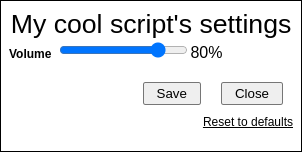user-scripts
A collection of user scripts I've made.
Range type for GM_config
This library provides the a “range” type (like
the <range> element; a slider representing a numeric value)
suitable for use with GM_config as a custom type. The result will
look something like the following:

The range type is exposed as a global named GM_config_range_type. It supports
all standard field settings, plus a few of its own (see the
Settings section below) and includes a text representation of the
slider’s current value (which can optionally be labeled or formatted).
Usage
There are two steps to using this type: adding a @require line to your
script’s metadata block, and specifying it as a custom type when initializing
GM_config.
Note the version number in the library’s URL on the @require line. Including
it allows you to get a newer version of the library (by changing the version
number to the latest) even if the user script extension doesn’t support updating
libraries. (The version number is ignore by GitHub Pages and exists solely for
your script’s benefit.)
Example:
// ==UserScript==
// @name My Cool Script
// @namespace https://example.com/
// @match https://*.example.com/*
// @require https://benblank.github.io/user-scripts/libraries/gm-config-range-type.lib.js?v=1.0.1
// @grant GM_getValue
// @grant GM_registerMenuCommand
// @grant GM_setValue
// ==/UserScript==
// Add the "@require" line above to your own script.
GM_registerMenuCommand('Configure my cool script', () => GM_config.open());
GM_config.init({
id: 'myCoolScript',
title: "My cool script's settings",
fields: {
volume: {
label: 'Volume',
type: 'range',
default: 80,
min: 0,
max: 100,
step: 10,
unitLabels: '%',
},
},
types: {
// Point the "range" type to the global "GM_config_range_type".
range: GM_config_range_type,
},
});
The resulting fields can be styled via CSS in the same manner as any other GM_config field.
Settings
The range type supports the following settings in addition to those common to all types:
-
min,max, andstepThese have the same meaning as for the
<range>element and are passed directly to it as attributes.The
listattribute is not currently supported by this custom type, due to limited browser support. -
unitLabelsIn addition to the range slider itself, the range type also adds text indicating its current value. The
unitLabelssetting allows you to customize this text by labelling it with the units your field represents. There are three ways of using it:-
falsy (e.g. unspecified,
false, the empty string, etc.)No unit label will be applied at all; only the bare, numeric value will be shown.
-
a string
If
unitLabelsis a single string, it will be directly appended to the current value (without a space). This is handy for e.g. percentages, where you can simply set it to"%". -
an array of two strings
If
unitLabelsis an array of two strings, the first will be used when the value is exactly one, and the second will be used for all other values. This is handy for standard units. For example, if your field represents a number of seconds, you can set it to[' second', ' seconds'](note the space at the beginning of each string).
-
-
formatterA more flexible alternative to
unitLabels. If provided, this function will be called with the field’s current value and settings when adding the current value text. Whatever it returns will be displayed as the current value. This could be used, for example, to store a value between 0 and 1, but display it as a percentage.Note that the
unitLabelssetting is a feature of the default formatter and will be ignored if you provide a custom formatter (unless you use it yourself).Example:
GM_config.init({ id: 'myCoolScript', title: "My cool script's settings", fields: { volume: { label: 'Volume', type: 'range', default: 0.8, min: 0, max: 1, step: 0.01, formatter(value, settings) { return `${Math.round(value * 100)}%`; }, }, }, types: { range: GM_config_range_type, }, });